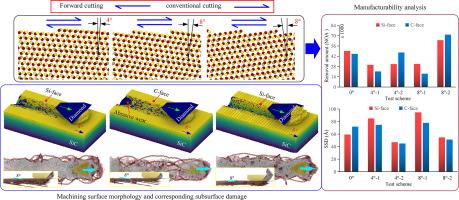优化六方碳化硅的可加工性并尽量减少位错滑移:离轴角度和加工表面类型的作用
IF 6.1
1区 工程技术
Q1 ENGINEERING, MANUFACTURING
引用次数: 0
摘要
本文研究了加工方向/平面和偏轴角度对单晶碳化硅去除过程的影响,并提出了新的发现。加工方向/平面和偏轴角度对材料去除量、磨料磨损量和表面下损伤层深度有直接影响。仅通过优化加工方向,材料去除量就可提高四倍。研究发现,与以往的研究不同,使用三角形金字塔磨料作为加工工具,Si 面的可加工性大大高于 C 面,尤其是当偏离轴线的角度选择为 0°时。此外,本文还对加工过程中的温度和应力成分进行了深入分析。分析结果表明,在洗牌组中出现的布尔格斯矢量 b = 1/3 < 112¯0 >以基底滑移为主,不受偏轴角度和晶面类型的影响,但基底滑移引起的位错深度与加工方向密切相关。作为用于外延生长的半导体衬底材料,加工表面/次表面区域不允许出现包括位错在内的损伤。本研究介绍了在加工方向、偏轴角和晶面类型耦合效应下次表面损伤的影响机制。本文章由计算机程序翻译,如有差异,请以英文原文为准。

Optimizing machinability and minimizing dislocation slip in hexagonal silicon carbide: The role of off-axis angle and processing surface type
This work investigates the effects of processing direction/plane and off-axis angle on the removal process of monocrystal SiC and presents new findings. The processing direction/plane and off-axis angle has a direct bearing on material removal amount, abrasive wear amount, and subsurface damage layer depth. Material removal amount can be increased by up to four times just by optimizing the processing direction. It was discovered that, different from previous studies, the use of triangular pyramid abrasives as the processing tool results in substantially higher machinability for the Si face compared to the C face, particularly when the off-axis angle is selected as 0°. In addition, the temperature and stress components during the processing process are thoroughly analyzed in this paper. According to the analysis, the Burgers vector b = 1/3 < 110 > occurring in the shuffle set is dominated by basal slip and is not affected by off-axis angle and crystal face type, but the dislocation depth caused by basal slip is closely related to the processing direction. As a semiconductor substrate material for epitaxial growth, damage including dislocations in the processed surface/subsurface area is not allowed. The influence mechanism of subsurface damage under the coupling effect of processing direction, off-axis angle and crystal face type is presented in this study.
求助全文
通过发布文献求助,成功后即可免费获取论文全文。
去求助
来源期刊

Journal of Manufacturing Processes
ENGINEERING, MANUFACTURING-
CiteScore
10.20
自引率
11.30%
发文量
833
审稿时长
50 days
期刊介绍:
The aim of the Journal of Manufacturing Processes (JMP) is to exchange current and future directions of manufacturing processes research, development and implementation, and to publish archival scholarly literature with a view to advancing state-of-the-art manufacturing processes and encouraging innovation for developing new and efficient processes. The journal will also publish from other research communities for rapid communication of innovative new concepts. Special-topic issues on emerging technologies and invited papers will also be published.
 求助内容:
求助内容: 应助结果提醒方式:
应助结果提醒方式:


